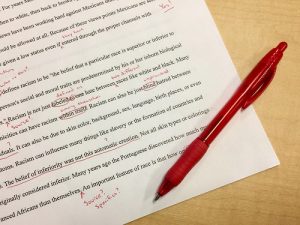What is Editing?
 Editing is a crucial process that enhances the accuracy, consistency, and quality of written content. It involves carefully revising, correcting, and modifying material to ensure it effectively conveys its intended message to the target audience. Therefore, our proofreading and editing services fix grammar, punctuation, and spelling errors, restructure text, and confirm that the content is accurate, relevant, and easily understood. Because we know our limitations, we only offer editing services in English.
Editing is a crucial process that enhances the accuracy, consistency, and quality of written content. It involves carefully revising, correcting, and modifying material to ensure it effectively conveys its intended message to the target audience. Therefore, our proofreading and editing services fix grammar, punctuation, and spelling errors, restructure text, and confirm that the content is accurate, relevant, and easily understood. Because we know our limitations, we only offer editing services in English.
Editor Skills
When it comes to producing a high-quality document, the role of the editor cannot be overstated. For this reason, it is essential to have an editor with the necessary skills to ensure your document is polished and error-free.
Language Skills
Having a strong command of the English language is crucial for an editor. It’s not just about identifying errors but also about having the ability to correct them. In addition, an editor must be able to differentiate between US and UK English and adhere to the appropriate standards. Punctuation mistakes, as explained in our article on punctuation, and grammar errors can drastically alter the meaning of a sentence or paragraph, underscoring the significance of precise editing.
Attention to Detail
Having a sharp eye for detail is an essential skill for an editor. The editor reviews the content to make it polished and error-free, playing a vital role in the process. Editors must be able to spot errors and inconsistencies in the content, such as grammatical errors, spelling mistakes, and factual inaccuracies, and correct them to ensure that the content is accurate, clear, and easy to read.
Communication Skills
Effective communication is a crucial skill for an editor. The editor plays a pivotal role in ensuring the polished and publication-ready quality of the content they review. Editors must be able to communicate effectively with authors and provide clear and concise feedback that enables everyone to understand and address any issues or concerns.
By providing feedback that is actionable and easy to understand, the editor can help guide the author toward creating high-quality content that meets the desired objectives. Effective communication also helps to foster collaboration among team members, which is vital for a successful content strategy.
Time Management
Time management is a crucial skill for an editor. The editor oversees multiple projects and ensures they are completed on time and to a high standard. Therefore, editors must be able to prioritise tasks effectively, manage their time efficiently, and meet tight deadlines without sacrificing the quality of their work.
Flexibility
As content creators continue to diversify their writing styles and approaches, editors need to have a versatile skillset that allows them to adapt to a variety of genres and writing styles. Thus, editors need to be able to navigate different tones and perspectives.
Style Guides
As editors are responsible for ensuring that written content adheres to established rules and regulations, it is important for them to be familiar with a variety of writing styles (for example, Associated Press (AP), Chicago Manual of Style (CMS), Modern Language Association (MLA), American Psychology Association (APA), Harvard, to name but a few). Each style has its own set of rules, guidelines, and requirements that dictate the formatting, style, and citation of content.
Editors must have a strong understanding of the specific style requirements and be able to apply them consistently and accurately. They should be able to identify common errors and inconsistencies in the content and be able to make necessary corrections to ensure that the content adheres to the specific style guidelines.
In addition, editors should also be able to communicate these guidelines effectively to authors. By doing so, editors can help to ensure that authors align their understanding of the specific style and produce consistent, polished content adhering to the highest quality standards.
Critical Thinking
In order to ensure that written content meets the desired objectives and resonates with the target audience, editors must be able to critically analyse the content and identify areas for improvement. This requires a keen eye for detail and a strong understanding of the audience and the desired tone and messaging.
While suggesting improvements, editors must also be able to maintain the author’s unique voice and intent and preserve the integrity and authenticity of the content. Therefore, editors must have a deep understanding of the author’s perspective, objectives, and style and be able to provide targeted feedback and suggestions that align with the author’s vision and voice.
Cultural Awareness
Editors play an important role in ensuring that written content is culturally sensitive and appropriate for the intended audience. For this reason, editors must have a deep understanding of cultural differences that may affect the content and be able to make the necessary adjustments to ensure that the content is respectful, inclusive, and effective.
Cultural differences can manifest in many ways, such as the use of language, imagery, or references. Editors must therefore identify and understand these differences and make appropriate adjustments to ensure that the content is tailored to the intended audience and aligns with cultural norms and values.
By having a deep understanding of cultural differences and being able to make necessary adjustments, editors can help to ensure that the content produced is effective, respectful, and inclusive and resonates with the intended audience.
Program Knowledge
For an editor to be effective, they must be proficient in the software they are using. They should be adept in using track changes and comments and be able to guide the client on how to use them, if necessary. These tools help to keep the editing process organised and facilitate communication between the editor and the client.
Content and Context
A thorough understanding of the content and context is critical for an editor to effectively edit a document. While an editor may be able to perform grammar and punctuation edits, they run the risk of altering the overall context of the document without a proper understanding of the subject matter.
Editing Services
Our editing services include but are not limited to:
Grammar Editing
Grammar editing focuses on correct grammar, syntax, and sentence structure. A grammar editor checks for errors such as subject-verb agreement, verb tense, and proper use of punctuation. They also check for clarity and coherence, ensuring they structure sentences well, create smooth flow, and clarify the overall meaning of the text.
Grammar editing produces writing that is free of grammatical errors.
Spelling Editing
Spelling editing corrects spelling errors. A spelling editor checks for typos, misspelt words, and other spelling mistakes. They use a spellchecker tool, a dictionary, or both, to verify the correct spelling of words in the text. They also look for homophones (e.g. “there” vs. “their”) and other common spelling mistakes.
Spelling editing produces text that is free of spelling errors.
Clarity Editing
Clarity editing ensures that the writing is easy to understand and the message is clear. A clarity editor checks for ambiguity or confusion in the text and rewrites or reorganises sentences or sections as needed. They also look for awkward or wordy phrasing and simplify it to improve the flow of text. Further, they may suggest the use of headings, subheadings, bullet points, and other elements to help break up the text and make it easier to read.
Clarity editing produces writing that is easy to understand and communicates its intended message to the reader.
Consistency Editing
Consistency editing maintains consistency in style, tone, and voice throughout a piece of writing. A consistency editor checks for and amends consistency in spelling, punctuation, grammar, formatting, and other elements of the text. They also make sure the language and tone used in the text are consistent with the intended message and audience. This may involve checking for consistency in terms of capitalisation, hyphenation, numbers, and use of abbreviations, among other things.
Consistency editing polishes the text, making it professional and free of inconsistencies, which makes it easier for the reader to understand and engage with.
Accuracy Editing
Accuracy editing verifies the accuracy and correctness of information. An accuracy editor checks for errors in facts, figures, statistics, dates, names, and other details in the text. They may also fact-check information cited or referenced in the text and verify the accuracy of any sources used.
Accuracy editing produces writing that is free from errors and accurately conveys its intended message. This type of editing is important for non-fiction writing, such as news articles, research papers, and academic texts, where the accuracy of information is critical. Accuracy editing also helps ensure that the text is trustworthy, credible, and reliable and that it effectively communicates its intended message.
Relevance Editing
Relevance editing ensures the content of a piece of writing is relevant and apt for its intended purpose and audience. A relevance editor checks for content that is off-topic, repetitive, or unnecessary and either removes it or revises it as needed. They also ensure the content follows a logical and coherent structure, effectively conveying its intended message to the reader.
Relevance editing creates writing that focuses on being concise and relevant. This type of editing is especially important for writing that has a specific purpose or target audience, such as advertisements, brochures, and other marketing materials where the relevance of content is crucial for achieving its intended goal.
Readability Editing
Readability editing makes a piece of writing easier to read and understand. A readability editor checks for sentence length, complexity, and clarity and makes changes to the vocabulary, tone, and style of the text to make it more accessible to the intended audience.
Readability editing produces writing that is easy to read and understand and effectively communicates its intended message for a wider or diverse audience, such as textbooks, instruction materials, or online content where readability is crucial for ensuring that the content is accessible and engaging to the reader.
Editing Options
 Because of our excellent grasp of English, we can offer all levels of editing. While our editing services do not cover formatting, we are happy to guide the document format. In addition, we offer a separate formatting service for clients who need assistance with this aspect of their document.
Because of our excellent grasp of English, we can offer all levels of editing. While our editing services do not cover formatting, we are happy to guide the document format. In addition, we offer a separate formatting service for clients who need assistance with this aspect of their document.
Proofreading
Proofreading is the lightest editing and is normally the final stage of the editing process. It involves checking the text for spelling, punctuation, and grammar errors. As the final stage of the editing process, proofreading makes sure the text is error-free and ready for publication.
Line editing
Line editing focuses on individual sentences and phrases in a text. It is a sentence-level edit that checks the language, grammar, and style of the text. Therefore, line editing makes the writing engaging, easy to read, and free of grammatical and spelling errors.
Here, we pay close attention to the flow and rhythm of the text and may suggest changes to sentence structure, word choice, and other elements of style. We also make sure the text is clear, concise, and free of awkward or unclear phrasing.
Normally, editors perform line editing after copy editing and before proofreading. It can help the author refine their writing and make it more polished and effective.
Copy Editing
Copy editing focuses on the language, grammar, spelling, punctuation, and style of a text. Therefore, copy editing makes the text clear, concise, and error-free while preserving the author’s intent. Here, we pay close attention to details and make sure the text is consistent in terms of spelling, punctuation, and style.
Copy editing involves fixing grammar and syntax errors, correcting spelling and punctuation mistakes, and making sure the text is easy to read and understand. We may also suggest changes to improve the flow and clarity of the text and help eliminate redundant or unclear information. Editors typically perform copy editing after developmental editing and content editing but before proofreading.
Content editing
Content editing improves the overall structure, flow, and clarity of a text. Therefore, content editing ensures logical organisation and clarity in the text, making the content compelling and relevant to the reader. This may involve rearranging sections, adding or deleting information, and ensuring logical structure. We may suggest changes to the pacing, tone, and style of the text, and help the author clarify their ideas and make their arguments more convincing.
Usually, editors perform content editing after developmental editing but before copy editing.
Developmental Editing
Developmental editing normally takes place at the early stages of writing and aims to help the author improve the overall structure and content of the text. It focuses on the big-picture aspects of a text and involves suggestions for reordering sections, adding or deleting information, and clarifying ideas. Therefore, developmental editing helps the author shape and refine their ideas into a cohesive, well-structured text.
We may provide feedback on the plot, characterisation, pacing, and other elements of storytelling, as well as suggest ways to make the text more engaging and effective.
Academic editing
Academic editing refers to editing academic writing such as research papers, theses, dissertations, and scholarly articles. Therefore, academic editing helps the author improve the clarity, coherence, and accuracy of their writing.
Academic editing involves a combination of content editing, copy editing, and proofreading with a focus on ensuring the text is accurate, well-supported, and conforms to academic conventions.
Turnaround Time
 We understand the importance of a quick turnaround time for our clients. However, we recognise that the turnaround time for each project may vary, depending on several factors. One of the most significant factors is the level of editing required for the document. For instance, proofreading, which is the simplest level of editing, takes less time than developmental editing, which involves more complex editing tasks such as rewriting and restructuring the document.
We understand the importance of a quick turnaround time for our clients. However, we recognise that the turnaround time for each project may vary, depending on several factors. One of the most significant factors is the level of editing required for the document. For instance, proofreading, which is the simplest level of editing, takes less time than developmental editing, which involves more complex editing tasks such as rewriting and restructuring the document.
In addition, the technicality of the content is another crucial factor in determining the turnaround time. Technical documents such as scientific reports, legal documents, and medical papers require more time to edit than non-technical documents. Other aspects that may influence the turnaround time include the font size, line spacing, and margins used in the document. These factors may affect the number of pages we can work on per day and, as such, can impact the turnaround time.
While we cannot provide a guaranteed turnaround time without first assessing the document, we strive to work as quickly as possible without compromising the quality of our work. We always complete projects within the agreed-upon timeline.
Document Format
 We offer comprehensive support for a range of editable formats, including Word, Excel, PowerPoint, and more. We understand that written material comes in various forms and we strive to ensure that we can provide high-quality editing services for all.
We offer comprehensive support for a range of editable formats, including Word, Excel, PowerPoint, and more. We understand that written material comes in various forms and we strive to ensure that we can provide high-quality editing services for all.
Note that, to initiate the editing process, printed materials and PDFs requiring editing must first be converted into an editable format through our typing services.

